A Fast and Cost-Effective Detection of Melamine by Surface Enhanced Raman Spectroscopy Using a Novel Hydrogen Bonding-Assisted Supramolecular Matrix and Gold-Coated Magnetic Nanoparticles
Abstract
:1. Introduction
2. Materials and Methods
2.1. Instruments and Reagents
2.2. Synthesis of Fe3O4/Au Gold Magnetic Nanoparticles
2.3. Synthesis of AOA-Coated Gold Magnetic Nanoparticles (Fe3O4/Au–AOA)
2.4. Synthesis of RhB-Conjugated AOA (AOA–RhB)
2.5. Detection of Melamine in Water Using [Fe3O4/Au–AOA•••Melamine•••AOA–RhB] as a Matrix
2.6. Detection of Melamine in Milk Using [Fe3O4/Au–AOA•••Melamine•••AOA–RhB] as a Matrix
3. Results and Discussion
3.1. Characteristics of Fe3O4/Au Gold Magnetic Nanoparticles by TEM and EDX
3.2. Characterization of AOA-Coated Gold Magnetic Nanoparticles (Fe3O4/Au–AOA) by FTIR
3.3. Characterization of RhB-Conjugated AOA (AOA–RhB) by FTIR
3.4. Characterization of [Fe3O4/Au–AOA•••Melamine•••AOA–RhB] Complex by FTIR
3.5. Detection of Melamine in Water Using [Fe3O4/Au–AOA•••Melamine•••AOA–RhB] as a Matrix
3.6. Detection of Melamine in Milk Using [Fe3O4/Au–AOA•••Melamine•••AOA–RhB] as a Matrix
4. Conclusions
Acknowledgments
Author Contributions
Conflicts of Interest
References
- Brown, C.A.; Jeong, K.S. Outbreaks of renal failure associated with melamine and cyanuric acid in dogs and cats in 2004 and 2007. J. Vet. Diagn. Investig. 2007, 19, 525–531. [Google Scholar] [CrossRef] [PubMed]
- Zhou, Q.; Liu, N.; Qie, Z.; Wang, Y.; Ning, B.; Gao, Z. Development of gold nanoparticle-based rapid detection kit for melamine in milk products. J. Agric. Food Chem. 2011, 59, 12006–12011. [Google Scholar] [CrossRef] [PubMed]
- Gao, L.H.; Jonsson, J.A. Determination of melamine in fresh milk with hollow fiber liquid phase microextraction based on ion-pair mechanism combined with high performance liquid chromatography. Anal. Lett. 2012, 45, 2310–2323. [Google Scholar] [CrossRef]
- Ren, S.T.; Xu, C.F.; Du, Y.X.; Gao, X.L.; Sun, Y.; Jiang, Y.N. The natural outcome of melamine-induced bladder stones with bladder epithelial hyperplasia after the withdrawal of melamine in mice. Food Chem. Toxicol. 2012, 50, 2318–2324. [Google Scholar] [CrossRef] [PubMed]
- Liu, J.D.; Liu, J.J.; Yuan, J.H.; Tao, G.H.; Wu, D.S.; Yang, X.F.; Yang, L.Q.; Huang, H.Y.; Zhou, L.; Xu, X.Y.; et al. Proteome of melamine urinary bladder stones and implication for stone formation. Toxicol. Lett. 2012, 212, 307–314. [Google Scholar] [CrossRef] [PubMed]
- Liu, C.C.; Wu, C.F.; Shiea, J.; Cho, Y.T.; Hsieh, T.J.; Chou, Y.H.; Chen, B.H.; Huang, S.P.; Wu, W.J.; Shen, J.T.; et al. Detection of melamine in a human renal uric acid stone by matrix-assisted laser desorption/ionization time-of-flight mass spectrometry (MALDI-TOF MS). Clin. Chim. Acta 2012, 413, 1689–1695. [Google Scholar] [CrossRef] [PubMed]
- Heck, H.D.; Tyl, R.W. The induction of bladder stones by terephthalic acid, dimethyl terephthalate, and melamine (2,4,6-triamino-s-triazine) and its relevance to risk assessment. Regul. Toxicol. Pharm. 1985, 5, 294–313. [Google Scholar] [CrossRef]
- Rovina, K.; Siddiquee, S. A review of recent advances in melamine detection techniques. J. Food Compos. Anal. 2015, 43, 25–38. [Google Scholar] [CrossRef]
- Lou, T.; Wang, Y.; Li, J.; Peng, H.; Xiong, H.; Chen, L. Rapid detection of melamine with 4-mercaptopyridine-modified gold nanoparticles by surface-enhanced Raman scattering. Anal. Bioanal. Chem. 2011, 401, 333–338. [Google Scholar] [CrossRef] [PubMed]
- Kim, A.; Barcelo, S.J.; Williams, R.S.; Li, Z. Melamine sensing in milk products by using surface enhanced Raman scattering. Anal. Chem. 2012, 84, 9303–9309. [Google Scholar] [CrossRef] [PubMed]
- Robinson, A.M.; Harroun, S.G.; Bergman, J.; Brosseau, C.L. Portable Electrochemical Surface-Enhanced Raman Spectroscopy System for Routine Spectroelectrochemical Analysis. Anal. Chem. 2012, 84, 1760–1764. [Google Scholar] [CrossRef] [PubMed]
- Ehling, S.; Tefera, S.; Ho, I.P. High-performance liquid chromatographic method for the simultaneous detection of the adulteration of cereal flours with melamine and related triazine by-products ammeline, ammelide, and cyanuric acid. Food Addit. Contam. 2007, 24, 1319–1325. [Google Scholar] [CrossRef] [PubMed]
- Squadrone, S.; Ferro, G.L.; Marchis, D.; Mauro, D.; Palmegiano, P.; Amato, G.; Poma Genin, E.; Abete, M.C. Determination of melamine in feed: Validation of a gas chromatography-mass spectrometry method according to 2004/882/CE regulation. Food Control 2010, 21, 714–718. [Google Scholar] [CrossRef]
- Zhou, Y.; Li, C.Y.; Li, Y.S.; Ren, H.L.; Lu, S.Y.; Tian, X.L.; Hao, Y.M.; Zhang, Y.Y.; Shen, Q.Y.; Liu, Z.S.; et al. Monoclonal antibody based inhibition ELISA as a new tool for the analysis of melamine in milk and pet food samples. Food Chem. 2012, 135, 2681–2686. [Google Scholar] [CrossRef] [PubMed]
- Fleischmann, M.; Hendra, P.J.; Mcquillan, A.J. Raman spectra of pyridine adsorbed at a silver electrode. Chem. Phys. Lett. 1974, 26, 163–166. [Google Scholar] [CrossRef]
- Jeanmaire, D.L.; Duyne, R.P.V. Surface Raman spectroelectrochemistry: Part I. Heterocyclic, aromatic, and aliphatic amines adsorbed on the anodized silver electrode. J. Electroanal. Chem. Interfacial Electrochem. 1977, 84, 1–20. [Google Scholar] [CrossRef]
- Pieczonka, N.P.; Acora, R.F. Single molecule analysis by surface-enhanced Raman scattering. Chem. Soc. Rev. 2008, 37, 946–954. [Google Scholar] [CrossRef] [PubMed]
- Lu, G.; Li, H.; Liusman, C.; Yin, Z.Y.; Wu, S.X.; Zhang, H. Surface enhanced Raman Scattering of Ag or Au nanoparticle-decorated reduced graphene oxide for detection of aromatic molecules. Chem. Sci. 2011, 2, 1817–1821. [Google Scholar] [CrossRef]
- Zhang, X.Y.; Zhao, J.; Whitney, A.V.; Elam, J.W.; Van Duyne, R.P. Ultrastable substrates for surface-enhanced Raman spectrosocopy: Al2O3 overlayers fabricated by atomic layer deposition yield improved anthrax biomarker detection. J. Am. Chem. Soc. 2006, 128, 10304–10309. [Google Scholar] [CrossRef] [PubMed]
- Cao, Y.C.; Jin, R.; Nam, J.M.; Thaxton, C.S.; Mirkin, C.A. Nanoparticles with Raman spectroscopic fingerprints for DNA and RNA detection. Science 2002, 297, 1536–1540. [Google Scholar] [CrossRef] [PubMed]
- Park, T.; Lee, S.; Seong, G.H.; Choo, J.; Lee, E.K.; Kim, Y.S.; Ji, W.H.; Hwang, S.Y.; Gweon, D.G.; Lee, S. Highly sensitive signal detection of duplex dye-labelled DNA oligonucleotides in a PDMS microfluidic chip: Confocal surface-enhanced Raman spectrosocopic study. Lab Chip 2005, 5, 437–442. [Google Scholar] [CrossRef] [PubMed]
- Sha, M.Y.; Penn, S.G.; Freeman, R.G.; Doering, W.E. Detection of human viral RNA via a combined fluorescence and SERS molecular beacon assay. Nanobiotechnology 2007, 3, 23–30. [Google Scholar] [CrossRef]
- Culha, M.; Stokes, D.; Allain, L.R.; Vo-Dinh, T. Surface-enhanced Raman scattering substrate based on a self-assembled monolayer for use in gene diagnostics. Anal. Chem. 2003, 75, 6196–6201. [Google Scholar] [CrossRef] [PubMed]
- Cao, Y.C.; Jin, R.; Nam, J.M.; Thaxton, C.S.; Mirkin, C.A. Raman dye-labeled Nanoparticle probes for proteins. J. Am. Chem. Soc. 2003, 125, 14676–14677. [Google Scholar] [CrossRef] [PubMed]
- Driskell, J.D.; Uhlenkamp, J.M.; Lipert, R.J.; Porter, M.D. Surface-enhanced Raman scattering immunoassays using a rotated capture substrate. Anal. Chem. 2007, 79, 4141–4148. [Google Scholar] [CrossRef] [PubMed]
- Gong, J.L.; Liang, Y.; Huang, Y.; Chen, J.W.; Jiang, J.H.; Shen, G.L.; Yu, R.Q. Ag/SiO2 core-shell nanoparticle-based surface-enhanced Raman probes for immunoassay of cancer marker using silica-coated magnetic nanoparticles as separation tools. Biosens. Bioelectron. 2007, 22, 1501–1507. [Google Scholar] [CrossRef] [PubMed]
- Neng, J.; Harpster, M.H.; Zhang, H.; Mecham, J.O.; Wilson, W.C.; Johnson, P. A versatile SERS-based immunoassay for immunoglobulin detection using antigen-coated gold nanoparticles and malachite green-conjugated protein A/G. Biosens. Bioelectron. 2010, 26, 1009–1015. [Google Scholar] [CrossRef] [PubMed]
- Neng, J.; Harpster, M.H.; Wilson, W.C.; Johnson, P. Surface-enhanced Raman scattering (SERS) detection of multiple viral antigens using magnetic capture of SERS-active nanoparticles. Biosens. Bioelectron. 2013, 41, 316–321. [Google Scholar] [CrossRef] [PubMed]
- Craig, A.P.; Franca, A.S.; Irudaaraj, J. Surface-enhanced Raman spectroscopy applied to food safety. Ann. Rev. Food Sci. Technol. 2013, 4, 369–380. [Google Scholar] [CrossRef] [PubMed]
- Zheng, J.; He, L. Surface-enhanced Raman spectroscopy for the chemical analysis of food. Compr. Rev. Food Sci. Food Saf. 2014, 13, 317–329. [Google Scholar]
- Wang, Y.L.; Ravindranath, S.; Irudaaraj, J. Separation and detection of multiple pathogens in a food matrix by magnetic SERS nanoprobes. Anal. Bioanal. Chem. 2011, 399, 1271–1278. [Google Scholar] [CrossRef] [PubMed]
- Guo, Z.; Cheng, Z.; Li, R.; Chen, L.; Lv, H.; Zhao, B.; Choo, J. One-step detection of melamine in milk by hollow gold chip based on surface-enhanced Raman scattering. Talanta 2014, 122, 80–84. [Google Scholar] [CrossRef] [PubMed]
- He, L.; Liu, Y.; Lin, M.; Awika, J.; Ledoux, D.R.; Li, H.; Mustapha, A. A new approach to measure melamine, cyanuric acid, and melamine cyanurate using surface enhanced Raman spectroscopy coupled with gold nanosubstrates. Sens. Instrum. Food Qual. 2008, 2, 66–71. [Google Scholar] [CrossRef]
- Chen, J.; Su, X.O.; Yao, Y.; Han, C.; Wang, S.; Zhao, Y. Highly sensitive detection using a one-step sample combined with a portable array SERS sensor. PLoS ONE 2016, 11, e0154402. [Google Scholar]
- Giovannozzi, A.M.; Rolle, F.; Sega, M.; Abete, M.C.; Marchis, D.; Rossi, A.M. Rapid and sensitive detection of melamine in milk with gold nanoparticles by Surface Enhanced Raman Scattering. Food Chem. 2014, 159, 250–256. [Google Scholar] [CrossRef] [PubMed]
- Lin, S.; Hasi, W.L.J.; Lin, X.; Han, S.Q.G.W.; Lou, X.T.; Yang, F.; Lin, D.Y.; Lu, Z.W. Rapid and sensitive SERS method for determination of Rhodamine B in chili powder with paper-based substrates. Anal. Methods 2015, 7, 5289–5294. [Google Scholar] [CrossRef]
- Lin, M.; He, L.; Awika, J.; Yang, L.; Ledoux, D.R.; Li, H.; Mustapha, A. Detection of melamine in gluten, chicken feed, and processed foods using Surface Enhanced Raman Spectroscopy and HPLC. J. Food Sci. 2008, 73, T129–T134. [Google Scholar] [CrossRef] [PubMed]
- Yu, W.W.; White, L.M. Chromatographic separation and detection of target analytes from complex samples using inkjet printed SERS substrates. Analyst 2013, 138, 3679–3686. [Google Scholar] [CrossRef] [PubMed]
- Wang, J.F.; Wu, X.Z.; Xiao, R.; Dong, P.T.; Wang, C.G. Performance-enhancing methods for Au film over nanosphere Surface-Enhanced Raman Scattering substrate and melamine detection application. PLoS ONE 2014, 9, 1–6. [Google Scholar] [CrossRef] [PubMed]
- Lee, H.; Kim, M.S.; Suh, S.W. Raman spectroscopy of sulphur-containing amino acids and their derivatives adsorbed on silver. J. Raman Spectrosc. 1991, 22, 91–96. [Google Scholar] [CrossRef]
- Yang, J.; Tan, X.; Shih, W.C.; Cheng, M.M. A sandwich substrate for ultrasensitive and label-free SERS spectroscopic detection of folic acid/methotrexate. Biomed. Microdevices 2014, 16, 673–679. [Google Scholar] [CrossRef] [PubMed]
- Ai, K.; Liu, Y.; Lu, L. Hydrogen-bonding recognition-induced color change of gold nanoparticles for visual detection of melamine in raw milk and infant formula. J. Am. Chem. Soc. 2009, 131, 9496–9497. [Google Scholar] [CrossRef] [PubMed]
- Xu, H.-R.; Zhang, Q.-C.; Ren, Y.-P.; Zhao, H.-X.; Long, L.-S.; Huang, R.-B.; Zheng, L.-S. The influence of water on dielectric property in cocrystal compound of [orotic acid] [melamine] H2O. CrystEngComm 2011, 13, 6361–6364. [Google Scholar] [CrossRef]
- Chen, Z.-X.; Su, X.-X.; Deng, S.-P. Molecular recognition of melamine by vesicles spontaneously formed from orotic acid derived bolaamphiphiles. J. Phys. Chem. B 2011, 115, 1798–1806. [Google Scholar] [CrossRef] [PubMed]
- Mirzabe, G.H.; Keshtkar, A.R. Application of response surface methodology for thorium adsorption on PVA/Fe3O4/SiO2/APTES nanohybrid adsorbent. J. Ind. Eng. Chem. 2015, 26, 277–285. [Google Scholar] [CrossRef]
- Frens, G. Controlled nucleation for regulation of particle-size in monodisperse gold suspensions. Nature 1972, 241, 20–22. [Google Scholar] [CrossRef]
- Boolchand, P.; Jin, M.; Novita, D.I.; Chakravarty, S. Raman scattering as a probe of intermediate phases in glassy networks. J. Raman Spectrosc. 2007, 38, 660–672. [Google Scholar] [CrossRef]
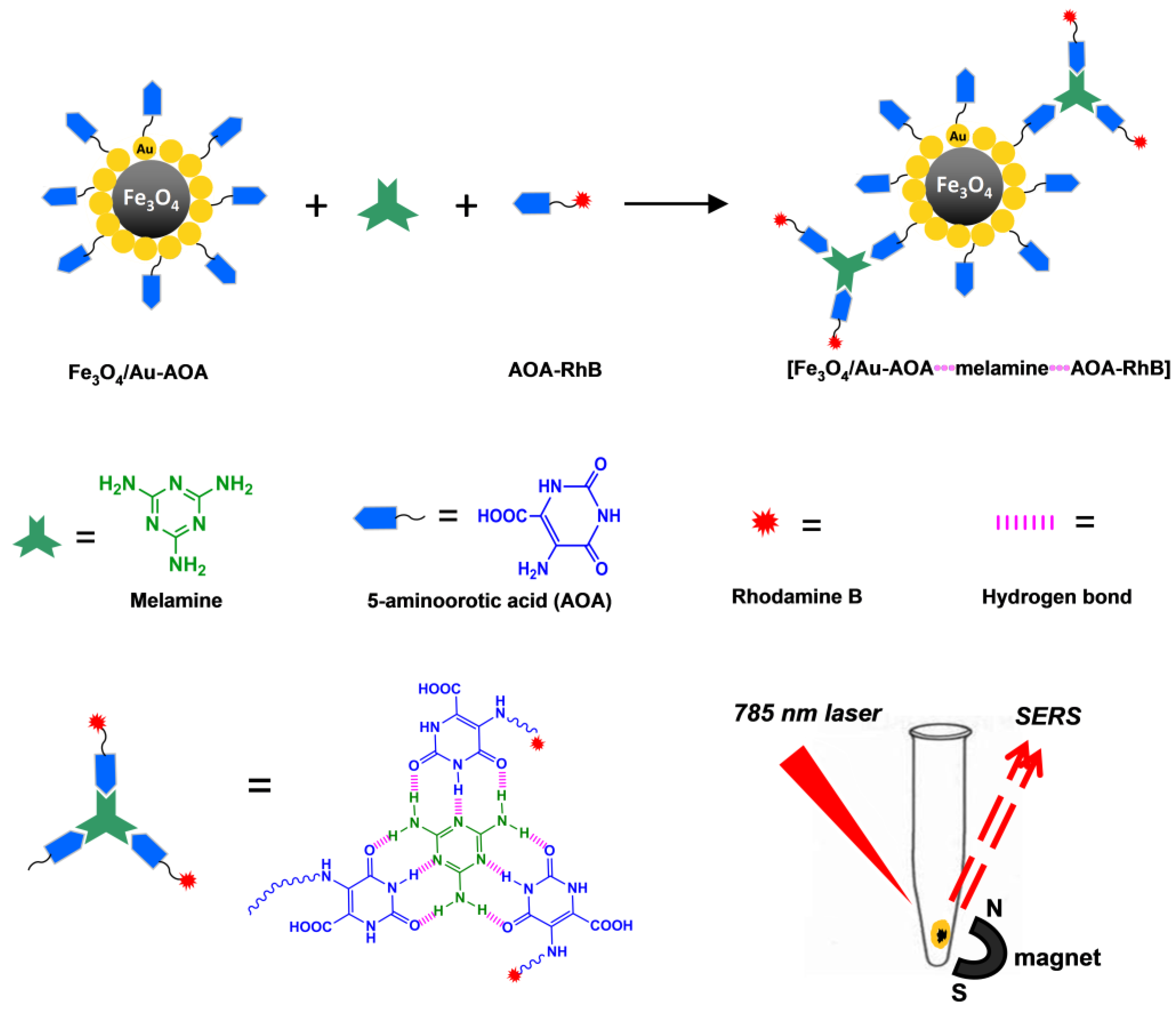
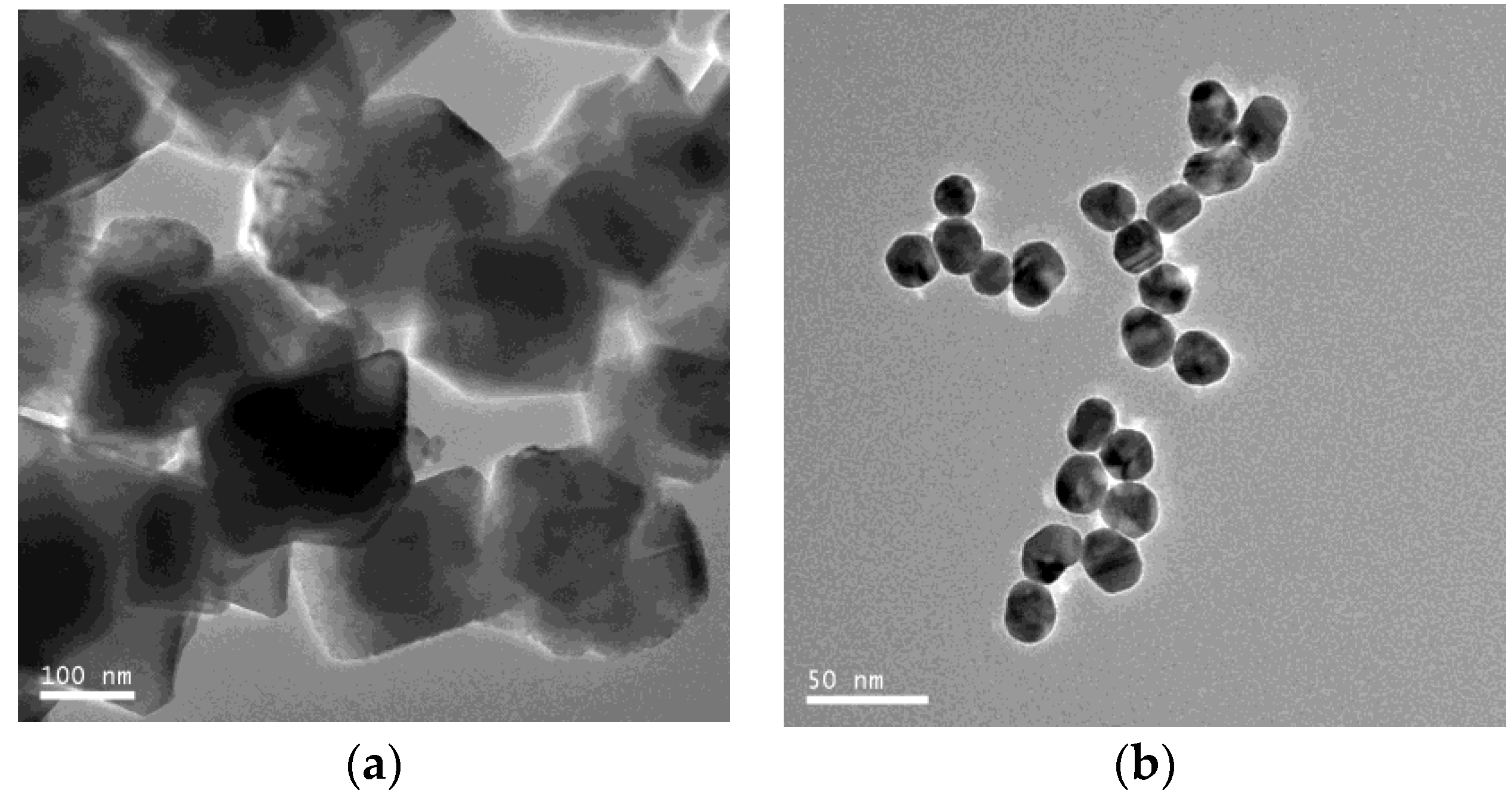
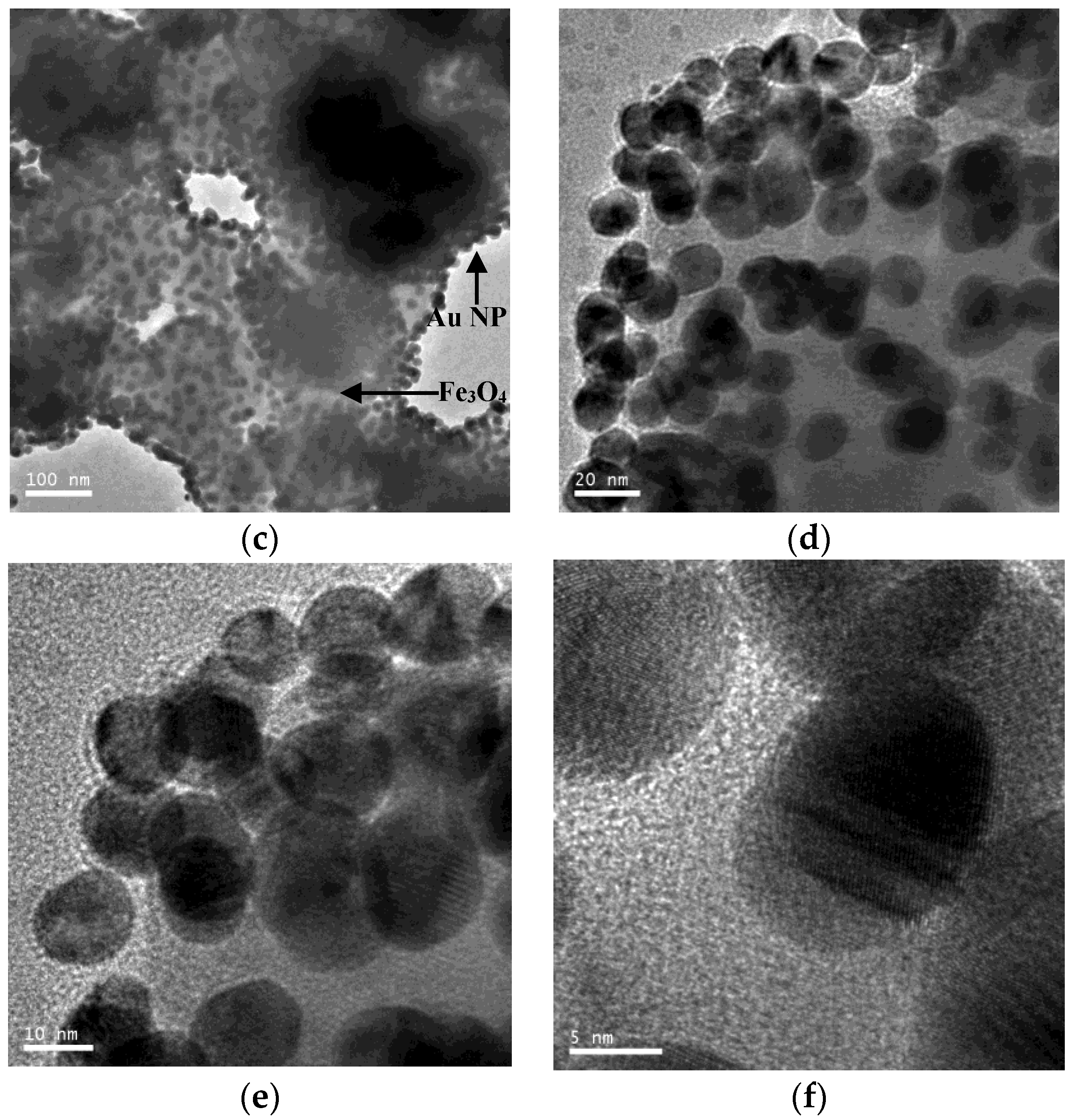
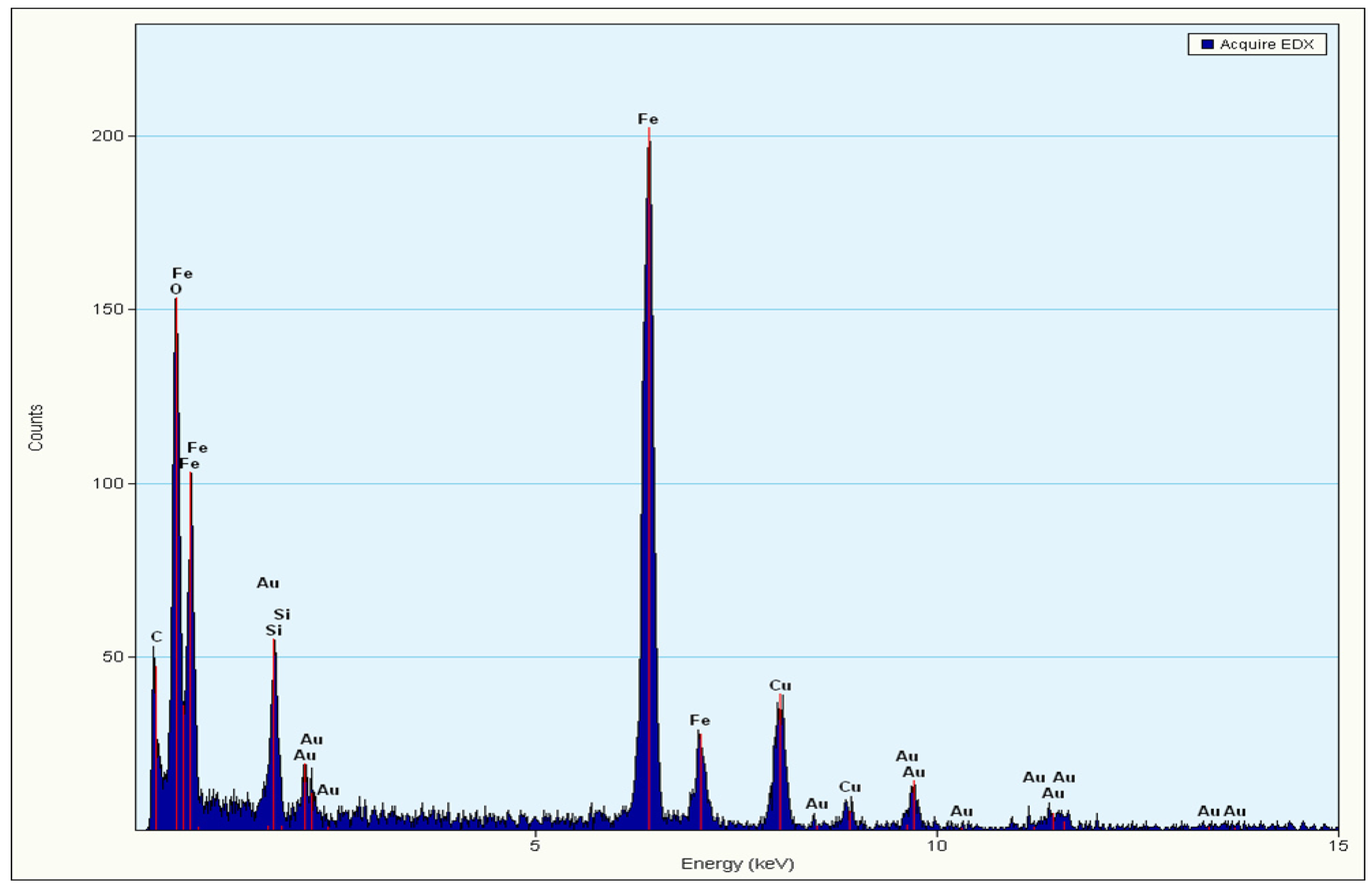
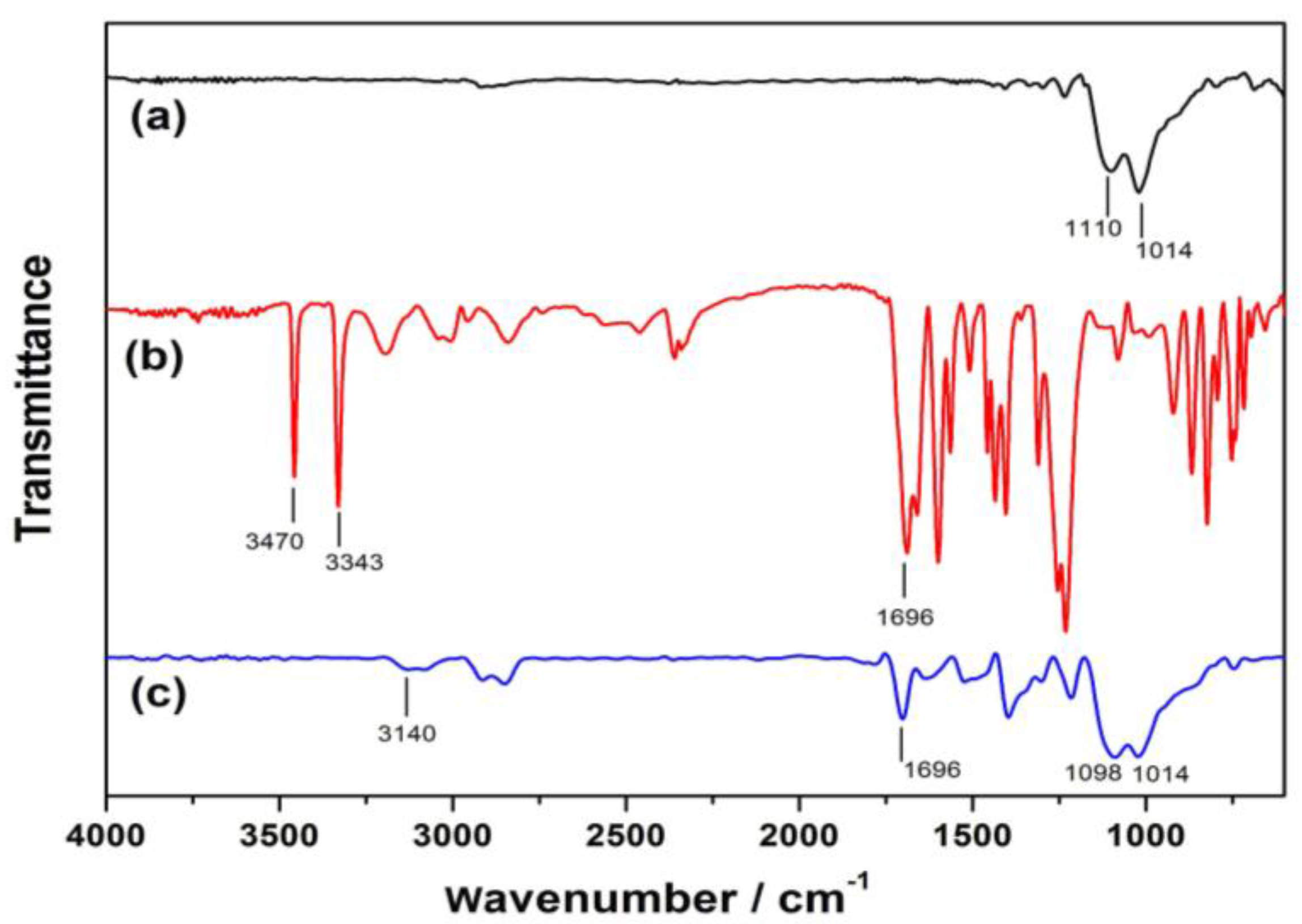
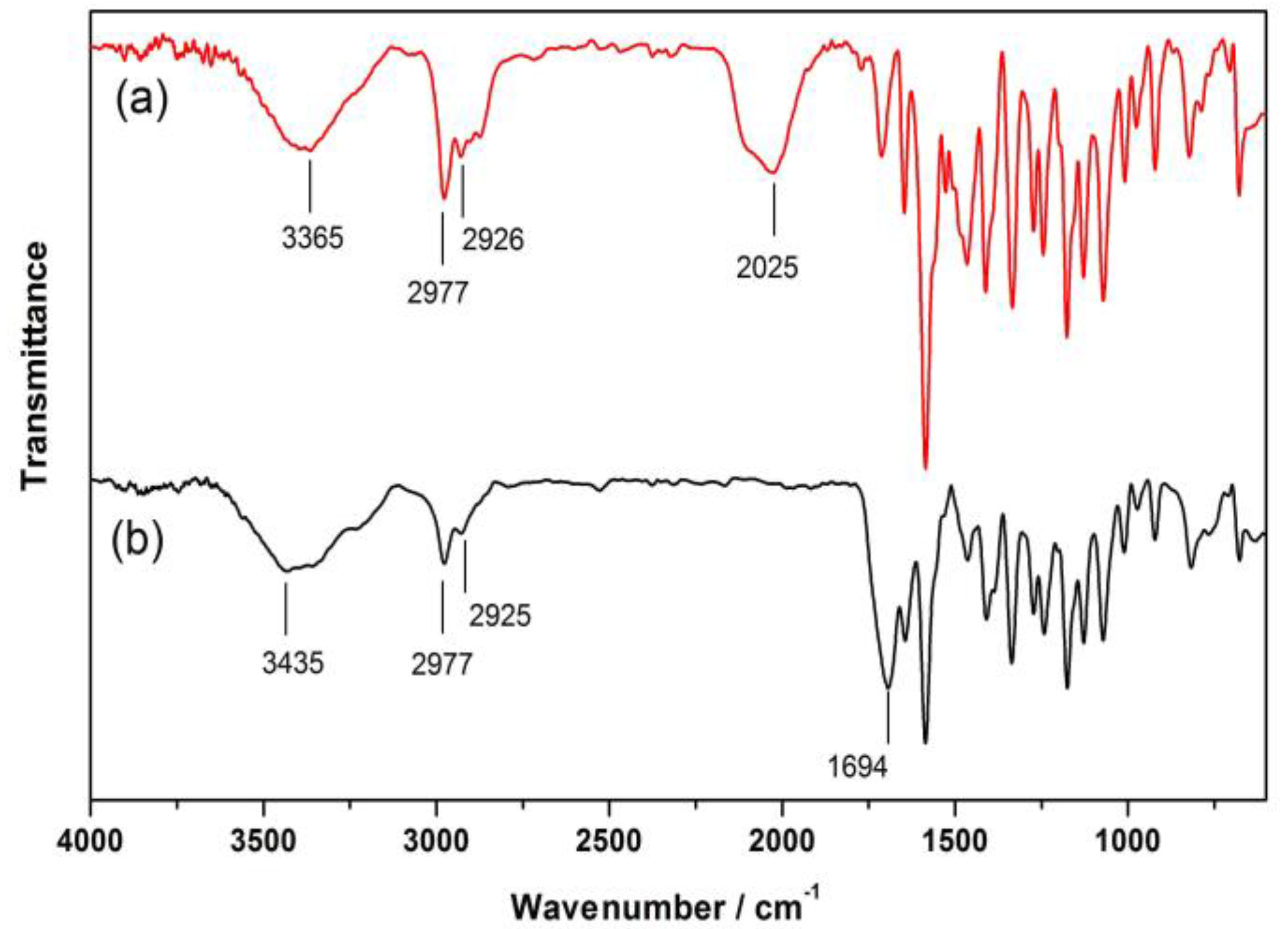
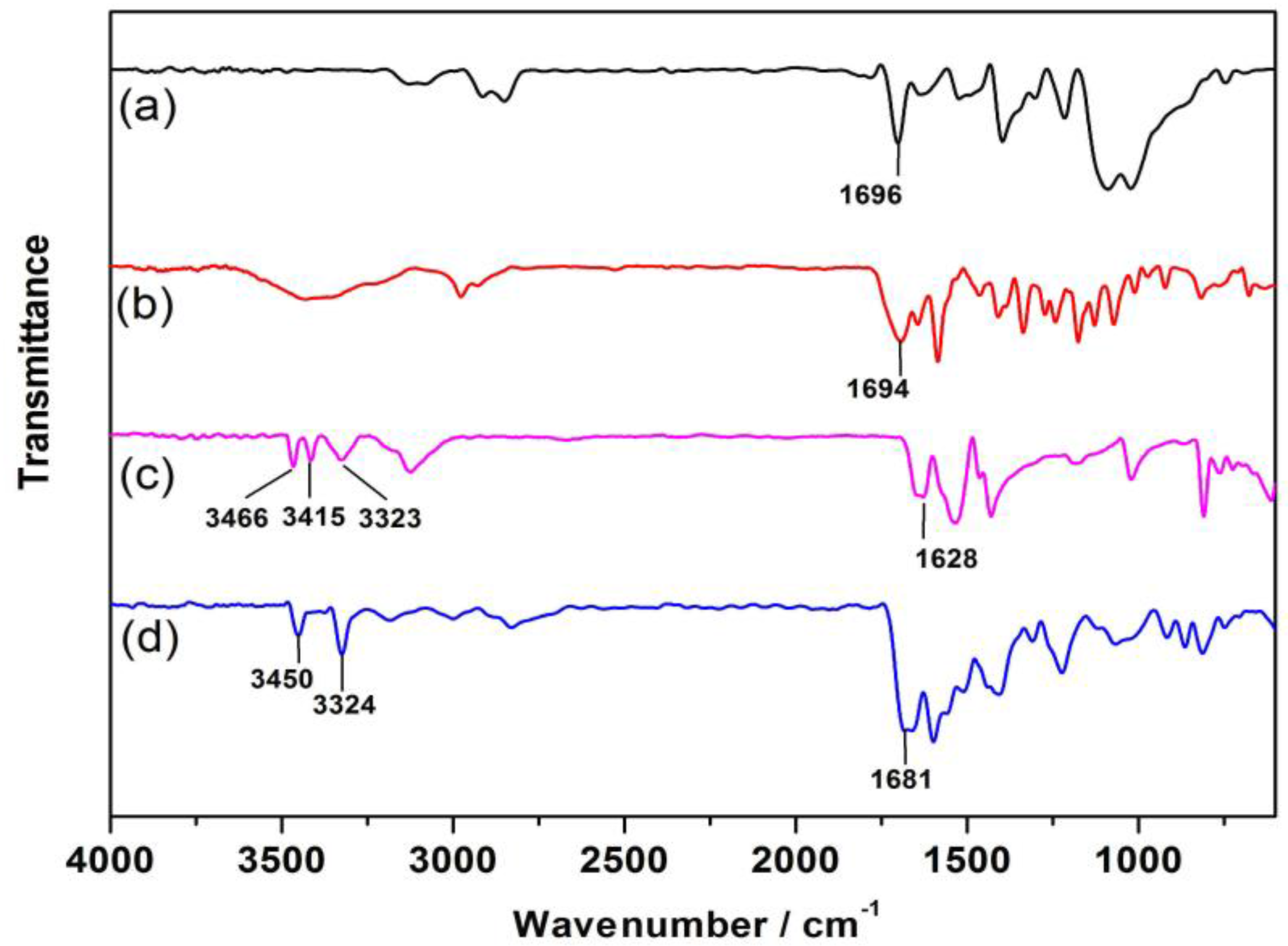
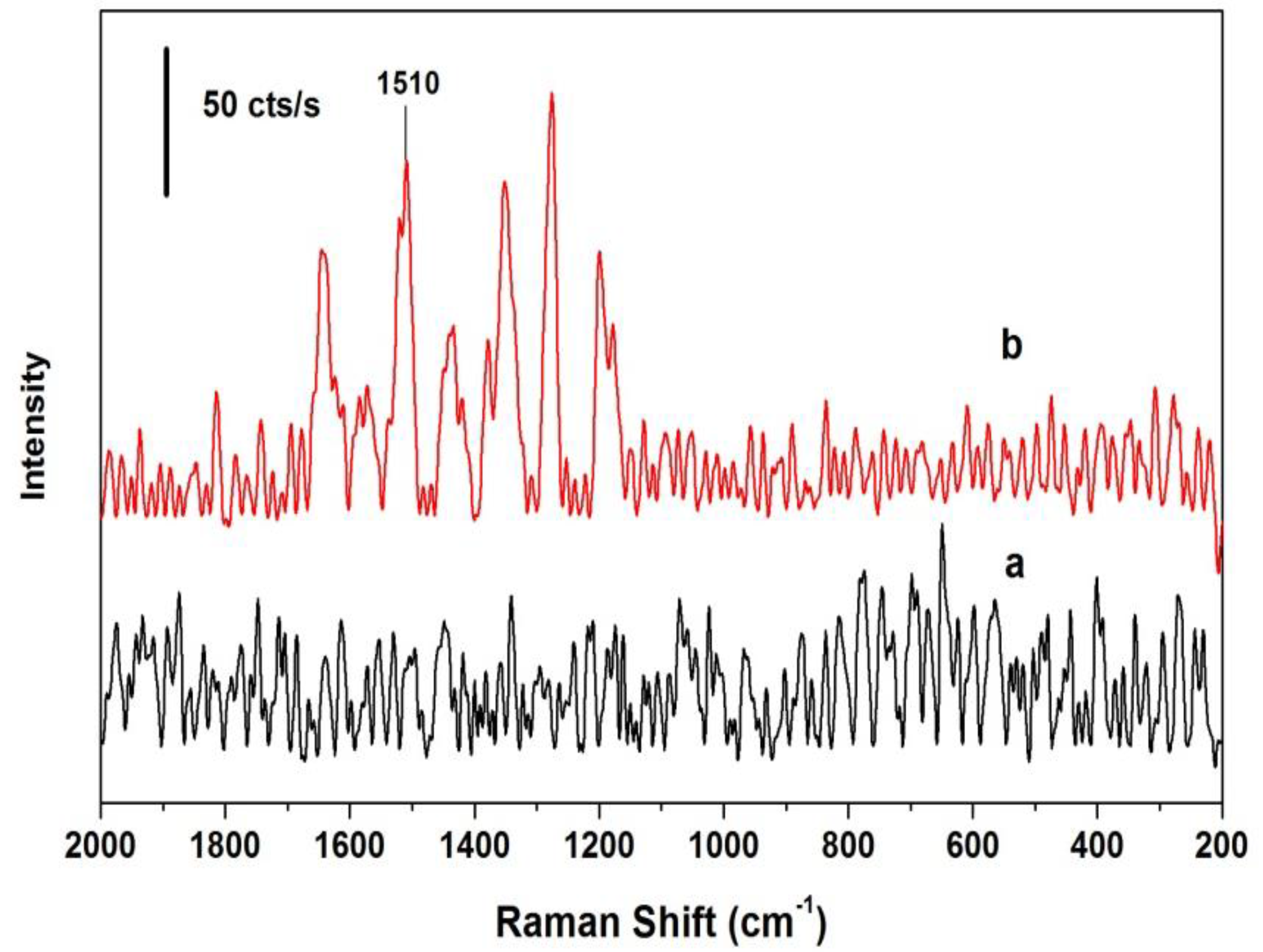

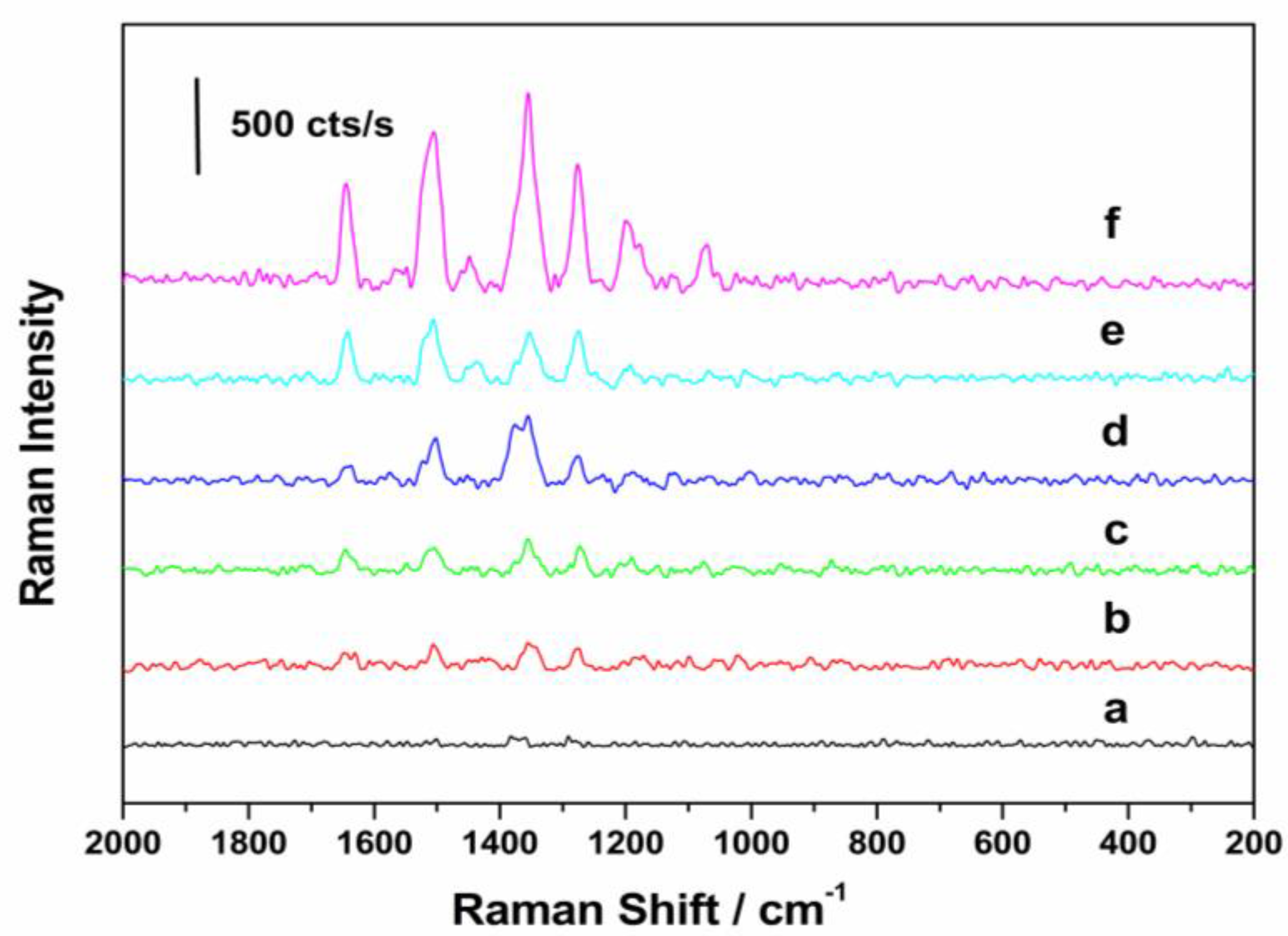
© 2017 by the authors. Licensee MDPI, Basel, Switzerland. This article is an open access article distributed under the terms and conditions of the Creative Commons Attribution (CC BY) license (http://creativecommons.org/licenses/by/4.0/).
Share and Cite
Neng, J.; Tan, J.; Jia, K.; Sun, P. A Fast and Cost-Effective Detection of Melamine by Surface Enhanced Raman Spectroscopy Using a Novel Hydrogen Bonding-Assisted Supramolecular Matrix and Gold-Coated Magnetic Nanoparticles. Appl. Sci. 2017, 7, 475. https://doi.org/10.3390/app7050475
Neng J, Tan J, Jia K, Sun P. A Fast and Cost-Effective Detection of Melamine by Surface Enhanced Raman Spectroscopy Using a Novel Hydrogen Bonding-Assisted Supramolecular Matrix and Gold-Coated Magnetic Nanoparticles. Applied Sciences. 2017; 7(5):475. https://doi.org/10.3390/app7050475
Chicago/Turabian StyleNeng, Jing, Jiayuan Tan, Kan Jia, and Peilong Sun. 2017. "A Fast and Cost-Effective Detection of Melamine by Surface Enhanced Raman Spectroscopy Using a Novel Hydrogen Bonding-Assisted Supramolecular Matrix and Gold-Coated Magnetic Nanoparticles" Applied Sciences 7, no. 5: 475. https://doi.org/10.3390/app7050475




